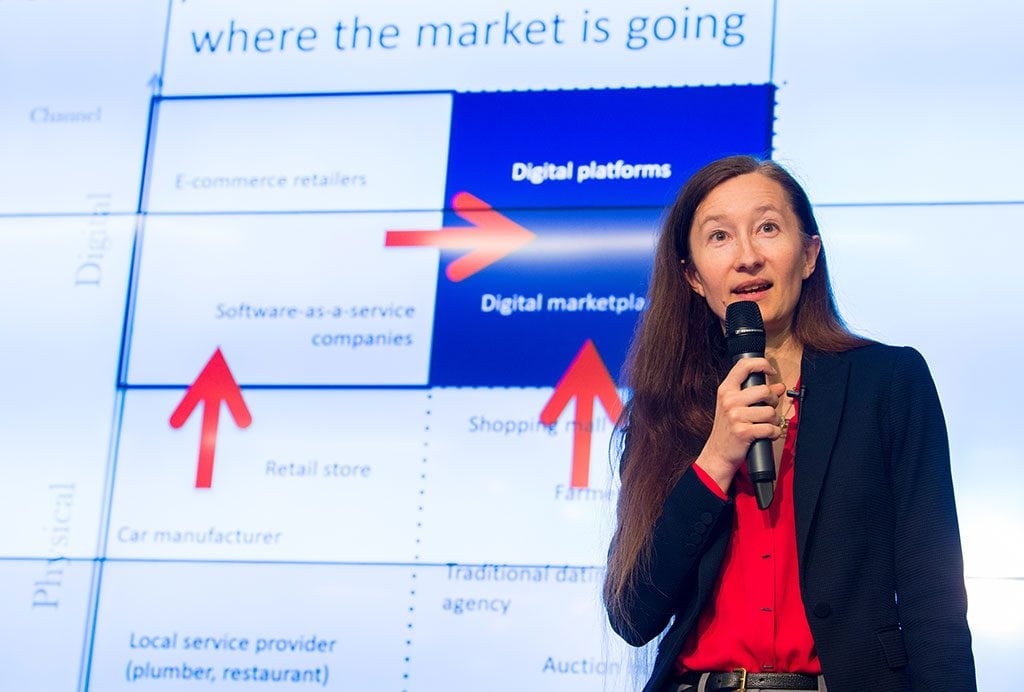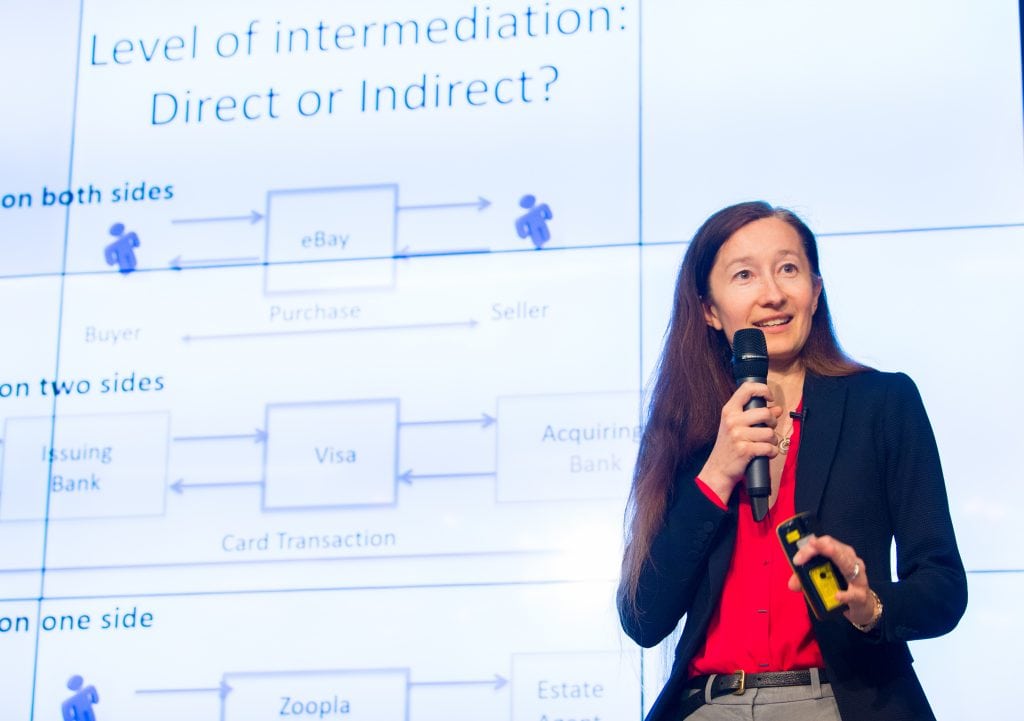Kicking off Marketplaces Connect 2018 at Rise London in Shoreditch, Laure Claire Reillier, Author of Platform Strategy and Co-Founder/COO of Launchworks & Co, described seven principles for a winning marketplace strategy.
Marketplaces are not linear businesses

Unlike the “value chain model” of traditional businesses, Laure explained that marketplaces operate more like ecosystems. This requires “rebooting” to a different kind of thinking. This is why Launchworks & Co has created the “Rocket” model to explain how marketplaces need to attract a critical mass of both producers and users. These two groups need to be matched in a way that is relevant, timely and filtered. They are then connected in order for them to transact. This might be anything from a purchase to a meeting on a dating platform. As the marketplace develops, it generates data that can be used to optimise the platform.
Key strategic enablers include governance – for example, regulating who can join the platform – trust, enabling people who don’t know each other to transact and finally brand, which must appeal to both users and producers. Other key enablers include IT, a payments system and user experience.
Like conventional rockets, it takes a lot of energy to launch a marketplace. This is because it involves launching two businesses at the same time – one for producers, one for users. An extra challenge is to keep them both in sync. But the good thing is that once launched, and a critical mass reached, less energy is required to grow as the market starts to develop its own momentum through “network effects”.
Marketplaces have different priorities across life stages
Broadly speaking, there are 4 main stages in creating a marketplace:
- Pre-launch – the design phase is about asking questions such as “who are my customers?”, “how do I add value to both producers and users?” and “what is the core interaction that I am trying to solve?”
- Ignition – starting to launch involves the “chicken and egg” question of whether to first attract users, producers or both at the same time!
- Scale-up – here the key challenge is to keep the right balance between active users and producers, known as balanced liquidity, before critical mass is achieved.
- Defensive growth – the final stage is about making the marketplace profitable and harnessing the power of the platform and network effects to generate further growth.

Develop two value propositions
In demonstrating the need to develop two value propositions, Laure compared the businesses of Hilton and Airbnb. For Hilton hotels, there is one value proposition for guests, based on the hotel services that they deliver around the world. By contrast, Airbnb offers two separate value propositions which they co-create with both guests and hosts. For guests it is about offering efficient search, trust, payments and insurance. For hosts it is about listing services, efficient matching, payment and insurance.
Think strategically about how you structure the market
On a more strategic level, the design process involves thinking about how you can configure your marketplace. Finding the optimal level of intermediation between buyers and sellers is one way to do this. For example, eBay is a direct platform with buyers and sellers connecting peer to peer. Alternatively, there are platform businesses that go through intermediaries on one side. Zoopla and Rightmove go through estate agents (with properties to sell) to match them with potential buyers. This is a different model from Purplebricks, which directly connects sellers and buyers. Sometimes platforms are even intermediated on both sides. Payment companies like Visa match merchants and card users via bank intermediaries (respectively banks acquiring merchants and banks issuing cards).

Get the cookie cutter right
When you want to ignite your marketplace, Laure says that “getting the cookie cutter right” is essential. Sometimes it can take several iterations to find the right market fit: you may have to try different pricing models, or pivot your strategy to gain traction before you can start scaling your business. A great example of this is BlaBlaCar, the car sharing platform, which made several attempts before finding the right model. What finally worked was to introduce prepayment at the booking stage. Having commitment from both sides dramatically reduced the cancellation rate from more than 35% to less than 3%. Suddenly, BlaBlaCar became a service that was reliable. From then on, the business started to scale exponentially, while trust between participants also increased significantly.
Trust and loyalty are your foundations
Scaling your marketplace without trust is very hard. You need to get to the point where there is enough trust in the marketplace so that people who don’t know each other can take a “leap of faith” and transact. But trust does not come naturally. It needs to be engineered by the platform with a trust framework. For example, it is key to make sure participants trust the concept of the platform, its implementation and ultimately the other users with whom they will transact. In order to achieve this platforms need to include verified information about the participants and reviews from other community members.
Skate to where puck is going not where it has been
The only way to defend your platform strategically is to know where the market is going. For the last fifteen years, the strong trend has been away from traditional, physical (bricks and mortar businesses) and towards digital platforms and marketplaces. So where’s the puck going next?
According to Laure, there are two major trends. Firstly, many of the world’s most successful companies such as Microsoft, Apple and Amazon are now combining platform and traditional business models, combining the strengths of both to create entire ecosystems that are worth more than the sum of their parts.
A second trend is about new technology such as blockchain and Artificial Intelligence that will pave the way for new distributed models that Laure calls “digital platforms 2.0”. We are now starting to see some very interesting and exciting new developments in terms of start-ups, new more distributed and decentralised organisations. And it’s not just start-ups. Facebook recently announced that it was investing in a new blockchain technology research wing. This is still an emerging area but with very significant potential for the future of platforms.
Did you like seven principles for a winning marketplace strategy?
If you liked this article, check write-ups from other Marketplaces Connect 2018’s presentations. Andrew Hooks, Carwow’s COO, shared his experience scaling one of the fastest growing startups in Europe in this insightful summary: 5 marketplace scaling lessons. Isomer Capital‘s Joe Schorge, Piton Capital‘s Andrin Bachmann and Felix Capital‘s Antoine Nussenbaum, delivered a brilliant panel on how to raise funds for your marketplace.

One comment on “Seven principles for a winning marketplace strategy”
Comments are closed.